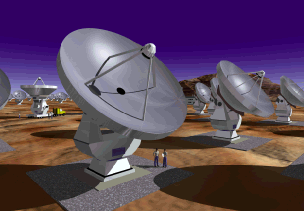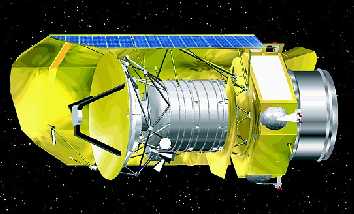
Astronomical spectroscopy has attracted perhaps the largest body of scientists and engineers working in the Submillimeter /Terahertz spectral region. That the line between scientists and the engineers is often blurred in this field is perhaps one of the chief reasons it has been so successful. The challenging technical problems of astronomy have not only driven and motivated the development of technology, but also have provided generally accepted and verifiable benchmarks.
The genesis of this astronomical activity can be traced back to the early days of microwave spectroscopy when techniques developed for millimeter spectroscopy were adapted in 1955 to detect radiation from the sun in the atmospheric window around 94 GHz [1]. The first observation of a polyatomic species in the interstellar medium, ammonia (NH3), was in 1968 by Townes and his coworkers Welsh, Rank, Thornton, and Cheung at the Hat Creek observatory [2]. This was followed closely by their discovery of water (H2O) [3]. Interestingly, two young post docs, Lew Snyder and David Buhl, at the National Radio Astronomical Observatory had previously applied for telescope time on their West Virginia facility, but their application to search for molecules in the interstellar medium had been turned down as a foolish waste of telescope time [4]. Shortly thereafter they were awarded telescope time and discovered formaldehyde (H2 CO) [5]. While it is fortuitous that these early searches in the centimeter spectral region were for molecules which turned out to be relatively abundant, none are as wide spread or as abundant as CO, whose 115 GHz J = 1 → 0 transition was the first to be discovered in the millimeter spectral region [6]. We will see below that the abundance of CO, along with its high correlation with the cosmically much more abundant but difficult to detect H2 and He, have made it an important beacon for astrophysical study of the structure and dynamics of both our galaxy and active star forming regions. An excellent history and overview of this field has been written by Winnewisser, Herbst, and Ungerechts [7].
At a basic level astronomical spectroscopy and atmospheric spectroscopy are very similar. Both detect the emission from molecules and, to first order, both use similar technology to do so: heterodyne receivers being extended from lower frequencies and optical interferometric techniques being extended from shorter wave-lengths.
It is instructive to start by considering the differences in the science (as well as in the resulting technology) for atmospheric and astronomical applications. In general the interstellar medium is colder, with temperatures typically not too many times that of the microwave background (2.7 K), but with hotter (100K - 1000K) regions as protostellar cores are approached. Additionally, the astronomical collision times are much longer in all circumstances. This long collision time, combined with fluxes of energetic particles, produces molecular systems which can be far from equilibrium in rotational state populations, partial pressures of gases (which for almost all species would approach zero under conditions dictated by vapor pressure), and abundances of ions, free radicals, and other reactive species. A useful measure of this non-equilibrium is that the lifetime of gaseous species in the interstellar medium is ~ 105 – 106 years before they freeze out on dust grains.
From the point of view of laboratory astrophysics, this leads to a rather different set of problems than those motivated by atmospheric science. Table V.B.1-1 shows a list of the molecular species that have been detected in the interstellar medium. A comparison of it with the species found in Figs.V.A-1 and V.A-2 is instructive.
An important first order effect in this comparison is simply one of atomic abundance. The atmospheric species are derivative of the major atmospheric components (N2, O2, and H2O) and man-made injections into the atmosphere. The interstellar species are driven more by cosmic abundances (H, C, O, N, . . .). Additionally, the interstellar list has many prominent ions and free radicals whose lifetimes under terrestrial conditions are very short. While spectral line frequencies are independent of the molecular environment after correction to rest velocity, their shapes and widths are not. Moreover, the inelastic rotational energy transfer rates which are closely related to pressure broadening (which is absent in the interstellar medium but of great significance in the recovery of atmospheric parameters from remote sensing data) are similarly necessary for the recovery of astronomical information from non-equilibrium interstellar medium.
Thus much of the emphasis in laboratory astrophysics has been on the development of laboratory environments both for the production of reactive species and ones in which low temperature collisional studies can be carried out. These have been considered in more detail above in Section IV.
V.B.1. Some Telescope Facilities 
V.B.2. Two Representative THz Telescopes 
V.B.3. Examples of other results: In this section we will briefly discuss a selection of astrophysical results based on Submillimeter /Terahertz observations to illustrate both the current technological state of the art as well as some of the science.
V.B.3.a. Mapping the Galaxy with CO

V.B.4. Laboratory Astrophysics
Advances in the sensitivity and angular resolving power of millimeter and submillimeter telescopes [8-10] are rapidly outpacing the spectroscopic data base, especially as they make possible more detailed studies of regions such as hot molecular cores. There is a strong consensus that the major contributors to this spectroscopic challenge are the spectra of difficult to analyze, low lying vibrational states that are excited at these temperatures, the so-called astrophysical weeds [11].
Quantum mechanical (QM) analyses [12, 13], which are the basis of these observations and the foundation of catalogs in the millimeter and submillimeter, rapidly become more challenging as analyses are extended from ground vibrational states (which are largely unperturbed) to excited vibrational states (which are often perturbed). It is the resulting incompleteness of the catalogs [14, 15] that accounts for the large majority of these unassignable astrophysical lines.
We have recently shown that an alternative to the QM analysis method, based on analyses of complete, intensity calibrated spectra taken at many temperatures, can dramatically increase the inclusiveness of astrophysical catalogs in the millimeter and submillimeter spectral region [16-18]. This method is much simpler because it requires neither spectral assignment nor model building for these complex perturbed spectra.
V.B.4.a The complete experimental spectra method
V.B.4.a.2 Intensity calibration
V.B.4.b QM Catalog completeness
V.B.4.e A Comparison of Laboratory and ALMA Spectra
References
[1] W. Gordy, S.J. Ditto, J.H. Wyman, R.S. Anderson, Phys. Rev., 99 (1955) 1905-1906.
[3] A.C. Cheung, D.M. Rank, C.H. Townes, W.J. Welch, Nature, 221 (1969) 917-919.
[4] C.H. Townes, How the Laser Happened: Adventures of a Scientist, Oxford, New York, 1999.
[5] L.E. Snyder, D. Buhl, B. Zuckerman, P. Palmer, Phys. Rev. Lett., 22 (1969) 679-681.
[6] R.W. Wilson, K.B. Jefferts, A.A. Penzias, Astrophys. J., 161 (1970) L43-L44.
[8] D. Clery, Science, 324 (2009) 584-586.
[9] J.L. Turner, H.A. Wooten, Highlights of Astronomy, 14 (2006) 521-522.
[10] E.E. Becklin, Advances in Space Research, 36 (2005) 1087-1090.
[12] G. Cazzoli, Z. Kisiel, J. Mol. Spectrosc., 130 (1988) 303-331.
[14] H.S.P. Muller, F. Schloder, J. Stutzki, G. Winnewisser, J. Mol. Struct., 742 (2005) 215-227.
[16] I.R. Medvedev, F.C. De Lucia, Astrophys. J., 656 (2007) 621-628.
[18] S.M. Fortman, I.R. Medvedev, C.F. Neese, F.C. De Lucia, Astrophys. J., 714 (2010) 476-486.